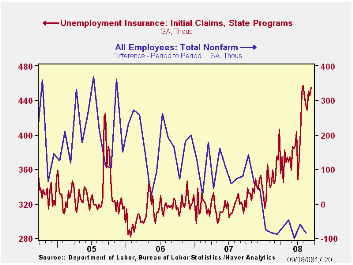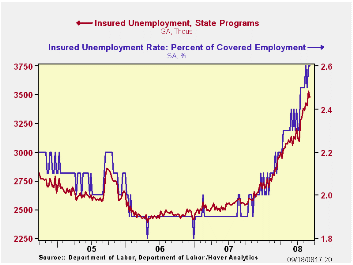 Global| Sep 18 2008
Global| Sep 18 2008U.S. Initial Unemployment Insurance Claims Near The Highest Since 2002
by:Tom Moeller
|in:Economy in Brief
Summary
Last week, initial claims for unemployment insurance rose to 455,000 from an unrevised level of 445,000 during the prior week. Except for a level at the beginning of last month which was raised by a program to locate and provide extra [...]

Last week, initial claims for unemployment insurance rose to 455,000 from an unrevised level of 445,000 during the prior week. Except for a level at the beginning of last month which was raised by a program to locate and provide extra benefits to people eligible for jobless benefits, the latest was the highest during this cycle. It also was the highest level since 2002.
The latest figure covers the survey week for September nonfarm payrolls and claims rose 20,000 (4.6%) from the August survey period. During the last ten years there has been a 76% correlation between the level of initial claims and the m/m change in nonfarm payroll employment
The four-week moving average rose to 445,000 (37.7% y/y) and remained near the highest level since near the end of the 2001 recession. Last month, claims averaged 443,000.
A claims level below 400,000 typically has been associated with positive growth in nonfarm payrolls. During the last ten years there has been a (negative) 76% correlation between the level of initial claims and the m/m change in nonfarm payroll employment. Over the longer period of time, the level of claims for jobless insurance has not trended higher with the size of the labor force due to a higher proportion of self-employed workers who are not eligible for benefits.
Continuing claims for unemployment insurance during the latest week fell 55,000 after a slightly revised 129,000 increase during the prior period. The four-week average rose to 3,461,000, the highest level since July 2003. Continuing claims provide some indication of workers' ability to find employment and they lag the initial claims figures by one week.
The insured rate of unemployment held stable w/w at 2.6%, the highest level since late-2003.
Yesterday's announcement by the Federal Reserve of measures "to improve the liquidity conditions in global financial markets" can be found here.
| Unemployment Insurance (000s) | 09/13/08 | 09/06/08 | Y/Y | 2007 | 2006 | 2005 |
|---|---|---|---|---|---|---|
| Initial Claims | 455 | 445 | 42.6% | 322 | 313 | 331 |
| Continuing Claims | -- | 3,478 | 36.2% | 2,552 | 2,459 | 2,662 |
Tom Moeller
AuthorMore in Author Profile »Prior to joining Haver Analytics in 2000, Mr. Moeller worked as the Economist at Chancellor Capital Management from 1985 to 1999. There, he developed comprehensive economic forecasts and interpreted economic data for equity and fixed income portfolio managers. Also at Chancellor, Mr. Moeller worked as an equity analyst and was responsible for researching and rating companies in the economically sensitive automobile and housing industries for investment in Chancellor’s equity portfolio. Prior to joining Chancellor, Mr. Moeller was an Economist at Citibank from 1979 to 1984. He also analyzed pricing behavior in the metals industry for the Council on Wage and Price Stability in Washington, D.C. In 1999, Mr. Moeller received the award for most accurate forecast from the Forecasters' Club of New York. From 1990 to 1992 he was President of the New York Association for Business Economists. Mr. Moeller earned an M.B.A. in Finance from Fordham University, where he graduated in 1987. He holds a Bachelor of Arts in Economics from George Washington University.






